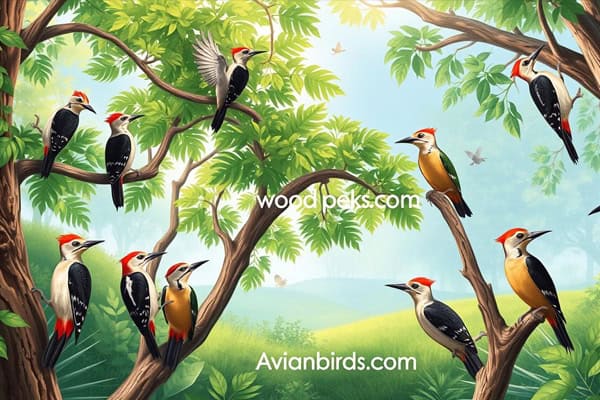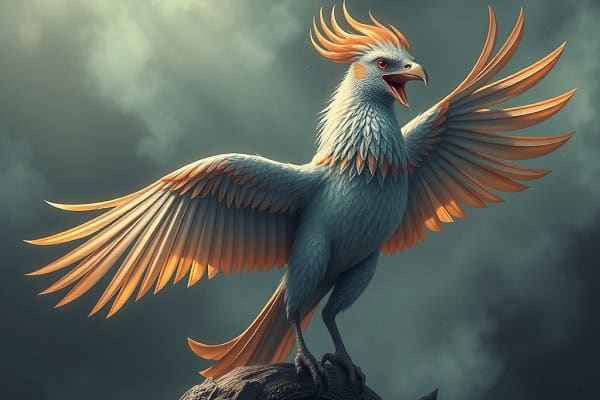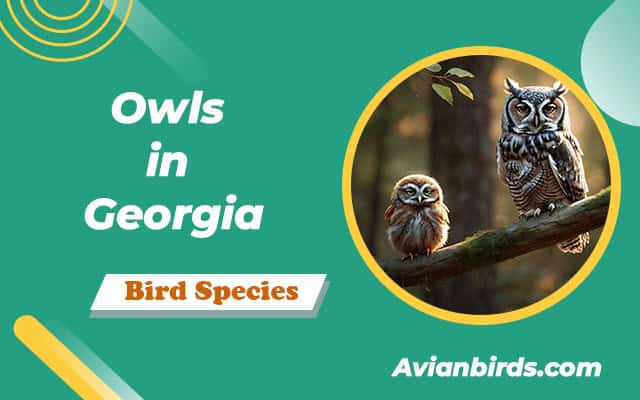Woodpeckers in Florida (8 Species You Can Spot)
Did you know Florida has eight different types of woodpeckers? These birds are not just pretty to look at. They help keep the environment balanced by controlling insects and making homes for other animals.
The biggest woodpecker, the Pileated Woodpecker, is quite heavy at 10.5 ounces. On the other hand, the Downy Woodpecker is very light, weighing only 0.8 ounces. This shows how diverse woodpeckers in Florida are.
This guide will give you cool facts about these birds. You’ll learn how to spot them, where they live, what they eat, and how to help protect them. Whether you love birds or enjoy nature, learning about woodpeckers in Florida will improve your birdwatching adventures.
Introduction to Florida’s Woodpecker Diversity
Florida’s different places are home to many woodpeckers. You can find them in wetlands and tall pine forests. These spots are great for birdwatching, showing off Florida’s birding wonders.
Woodpeckers have cool behaviors like drumming and pecking. These actions help them survive and find mates. For example, the Downy Woodpecker drums fast, up to 20 beats a second. This attracts mates and marks their territory.
Woodpeckers are key to knowing Florida’s natural world. Watching them in Florida’s varied landscapes is a special experience. Their presence shows a healthy environment where many can thrive.
Woodpeckers in Florida: An Overview
Florida is home to many woodpeckers. Eight native species live here, each suited to different places. You can find red-bellied, downy, hairy, red-headed, red-cockaded, pileated woodpeckers, yellow-bellied sapsuckers, and northern flickers.
The red-bellied woodpecker is the most common in Florida. They are 9 to 10.5 inches long and live in the south. The downy woodpecker is the smallest, at 6.1 inches, with a red crown on males.
The pileated woodpecker is the biggest, up to 17.5 inches long. They like big forests. The red-cockaded woodpecker is endangered, with only 1,100 families in Florida, making up 25% of their population.
Woodpeckers have different ways of eating and look. They have special feet for climbing trees, except for a few. Birdwatchers in Florida can see these unique birds and their behaviors in the state’s varied landscapes.
1. Red-Headed Woodpecker
- Scientific Name: Melanerpes erythrocephalus
- Size: 22–26 cm (8.7–10.2 in)
- Weight: 70–100 g (2.5–3.5 oz)
- Lifespan: Up to 9 years in the wild
- Diet: Insects, fruits, nuts, and seeds, often foraging on the ground
The Red-Headed Woodpecker is a standout in Florida. It has bright colors and interesting behaviors. Knowing how to spot them makes birdwatching more fun.
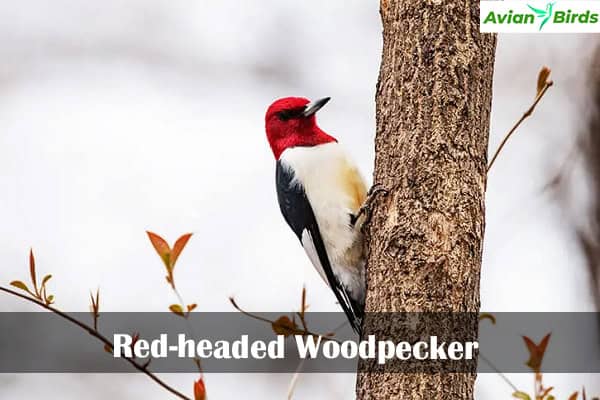
Identification and Characteristics
The Red-Headed Woodpecker is easy to spot. It has a bright red head, black back, and white belly. Adults are 19 to 25 cm long and weigh 56 to 97 g.
They have big heads and strong bills. This helps them find food. Young birds have gray-brown heads and white wings with black spots.
They are smaller than some woodpeckers but can fly well. This lets them catch insects in mid-air.
Diet and Feeding Habits
Red-Headed Woodpeckers eat insects, fruits, and seeds. They forage in trees and catch insects in flight. This shows their agility.
Moreover, They can forage upside down. They also steal food from other birds’ nests. They like to eat beetles and caterpillars from trees and fence posts.
Where to Spot Them in Florida
Florida is a great place to see Red-Headed Woodpeckers. They like pine savannas, wetlands, and urban parks. Some good places to watch them are:
- Paynes Prairie Preserve State Park
- Ocala National Forest
- Merritt Island National Wildlife Refuge
Early mornings and late afternoons are best for watching them. Look for their bright colors and unique flight.
Must Read: Woodpeckers in Wisconsin
- Scientific Name: Melanerpes carolinus
- Size: 23–25 cm (9–10 in)
- Weight: 70–100 g (2.5–3.5 oz)
- Lifespan: Up to 12 years in the wild
- Diet: Insects, fruits, nuts, and seeds
The Red-Bellied Woodpecker (Melanerpes carolinus) is a standout in Florida’s bird world. Knowing its looks and actions helps us enjoy it in nature.

Physical Features and Identifying Marks
Finding the Red-Bellied Woodpecker is simple with its clear signs. It has a bright red crown and neck. It also has a big white patch at its tail base. Its black and white back makes it easy to spot.
These birds are 22.85 to 26.7 cm long. They have a wingspan of 38 to 46 cm. They weigh 57 to 91 grams.
Behavior and Habitat Preferences
Watching Red-Bellied Woodpeckers is interesting. Plus, They are very protective of their territory, especially when they’re looking for a mate. They even tap on aluminum gutters to get attention.
They love places with lots of dead trees. This helps them find insects to eat.
Best Locations to See Red-Bellied Woodpeckers
Seeing Red-Bellied Woodpeckers is a great experience. The best places are the Apalachicola and Ocala National Forests. State parks like Paynes Prairie State Park are also good spots.
These places offer food and homes for the birds. So, you have a good chance of seeing them.
Also read: Woodpeckers in Texas
3. Pileated Woodpecker
- Scientific Name: Dryocopus pileatus
- Size: 38–49 cm (15–19 in)
- Weight: 250–400 g (8.8–14.1 oz)
- Lifespan: Up to 12 years in the wild
- Diet: Primarily wood-boring insects
The Pileated Woodpecker is a bird that stands out with its size and looks. It’s one of the biggest woodpeckers in North America. It can be as long as 16 to 19 inches, like a crow.
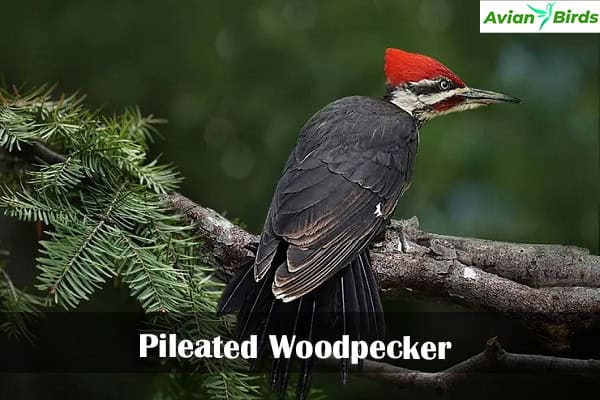
It has black feathers with white neck spots and a bright red crest, which makes it easy to spot from afar.
Identification and Size
When you see a Pileated Woodpecker, you’ll notice its unique traits. Males have a red crest and a red cheek stripe. Females have a red crest but no cheek stripe.
They weigh about 277 grams. Males are a bit heavier, and females are a bit lighter. Their wingspan is 66 to 75 centimeters, making them strong flyers.
Nesting Behavior and Feeding Preferences
Pileated Woodpeckers make their nests in big holes in dead wood. They usually lay three to five eggs for 12 to 16 days. Furthermore, They find food like wood-boring beetles and carpenter ants under dead tree bark.
They make rectangular holes while searching for food. This shows how powerful their beaks are.
Favorite Habitats in Florida
To see Pileated Woodpeckers, you need to go to certain wooded areas. They like mature forests with big trees, like in Apalachicola and Ocala National Forests. Myakka River State Park is also a good place to find them.
They need dead trees for nesting and food. This makes them a common sight in Florida. They are good at living in different types of forests.
Must Visit: Woodpeckers Of Ohio
| Characteristic | Description |
|---|---|
| Size | 16-19 inches in length |
| Weight | Averages 277 grams (males 300g, females 256g) |
| Wingspan | 66-75 centimeters |
| Nesting | Excavates cavities in dead trees |
| Diet | Mainly ants and wood-boring beetles |
| Preferred Habitat | Mature forests with large, dead trees |
4. Downy Woodpecker
- Scientific Name: Picoides pubescens
- Size: 14–19 cm (5.5–7.5 in)
- Weight: 28–90 g (1–3.2 oz)
- Lifespan: Up to 10 years in the wild
- Diet: Insects, larvae, seeds, and berries.
The Downy Woodpecker (Picoides pubescens) is a charming bird. It’s easy to spot because of its size and markings. This bird loves many places, making it fun to watch for bird lovers.

Size and Distinguishing Features
Downy Woodpeckers are small, about six to seven inches long. They are the smallest woodpeckers in North America. They look like the Hairy Woodpecker but are much smaller.
Their feathers are black and white. Males have a small red patch on their heads. Woodpeckers in the west are darker than those in the east. In the Pacific Northwest, they might look even darker.
Feeding Habits and Diet
Downy Woodpeckers mainly eat insects like ants and beetles. Also, They use their beaks to get insects from tree bark. They also like suet and seeds from bird feeders.
They help keep insects away from your garden. This makes them great friends for gardeners.
| Feature | Description |
|---|---|
| Size | 6-7 inches long, smaller than Hairy Woodpecker |
| Distinctive Markings | Black and white plumage, male has a red patch |
| Diet | Mainly insects (ants, beetles), also suet and seeds |
| Habitat | Open woodlands, suburban yards, parks, and orchards |
| Western vs Eastern | Western Downy Woodpeckers are darker overall |
Must read: Woodpeckers in Montana
Woodpecker Conservation Status in Florida
Woodpeckers in Florida need our help to survive. The Red-Bellied Woodpecker is common, but the Red-Cockaded Woodpecker is endangered. We must protect these birds and their homes to keep nature balanced.
Common and Endangered Species
The Red-Cockaded Woodpecker is a big worry. It’s endangered and needs special care. Losing its home is a big problem for it.
This woodpecker takes a long time to make a nest. It can take up to six years. Florida is home to most of its nests.
Conservation Efforts and Challenges
Groups are working hard to save woodpeckers. They focus on keeping longleaf pine forests safe. The St. Sebastian River Preserve is a key place for them.
The U.S. Fish and Wildlife Service is moving woodpeckers to new homes. But, cities and trees being cut down are big problems. We must find a way to grow cities without hurting woodpeckers’ homes.
Tips for Spotting Woodpeckers in Florida
When you go to Florida to see woodpeckers, using good spotting tips and birdwatching practices helps a lot. The best times to see them are early morning and late afternoon. Bring binoculars for a closer look.
Best Observing Practices
To see woodpeckers, follow these birdwatching tips:
- Go out early in the morning or late in the afternoon.
- Be quiet and still to not scare the birds.
- Use binoculars for a better view without getting too close.
- Listen for their unique calls and drumming sounds.
- Look for trees with marks or holes, signs of woodpeckers.
Recommended Locations for Birdwatching
Florida has many great places to see woodpeckers. Some top spots are:
- Ocala National Forest: It has lots of deciduous trees.
- Apalachicola National Forest: It’s known for its beautiful woodlands and wildlife.
- Local state parks: They have wildlife areas where you can see woodpeckers.
- Wildlife refuges: They are great for seeing many bird species.
Visiting these places in Florida can help you see different woodpeckers. Look for areas with lots of trees and dead wood. These places attract woodpeckers. By following these tips and visiting the right places, you’ll enjoy birdwatching more and learn to love these amazing birds.
Why Woodpeckers Matter to Florida’s Ecosystem
Woodpeckers are more than just pretty birds. They help keep Florida’s forests healthy. They also help keep the ecosystem balanced. This makes them key to saving our forests.
Impact on Forest Health
Woodpeckers fight off insects that harm trees. They make homes in dead trees, helping them decay. This decay helps other animals find homes too.
They also help by eating insects on the ground and in the air. This helps trees stay strong and healthy.
Importance in Biodiversity
Woodpeckers show us a healthy ecosystem. In Florida, 11 types of woodpeckers live. They help many other plants and animals survive.
By saving woodpeckers, we help all species live together. This makes our natural world a better place.
| Woodpecker Species | Contribution to Ecosystem | Impact on Forest Health |
|---|---|---|
| Red-headed Woodpecker | Controls insect populations | Aids in habitat creation through cavity nesting |
| Red-cockaded Woodpecker | Supports longleaf pine ecosystems | Facilitates decay processes, promoting new growth |
| Pileated Woodpecker | Enhances biodiversity by creating cavities | Improves forest health through natural foraging |
Read More🐦Related Articles:
| Woodpeckers in Arkansas |
| Barn Swallow: Everything You Need To Know |
| Doves in Kansas |
| Greater White-Fronted Goose: Facts & Habitat |
| Bar-Headed Goose: High-Flying Himalayan Marvel |
Conclusion
Florida is full of woodpecker species, each playing a special role in the ecosystem. Learning about these birds helps us understand their lives and habitats. It also shows us how important they are for keeping nature in balance.
The variety of woodpeckers in Florida reminds us to work hard to protect them. We must save their homes in nature. This is key for their survival.
Birdwatching lets you see Florida’s wildlife up close. Watching woodpeckers makes you want to help protect them. It’s a fun way to learn about nature and its challenges.
Woodpeckers and their homes tell a big story about nature and saving it. Knowing their value lets us help protect them and their homes. Learning about Florida’s woodpeckers is just the first step to connecting with nature.

